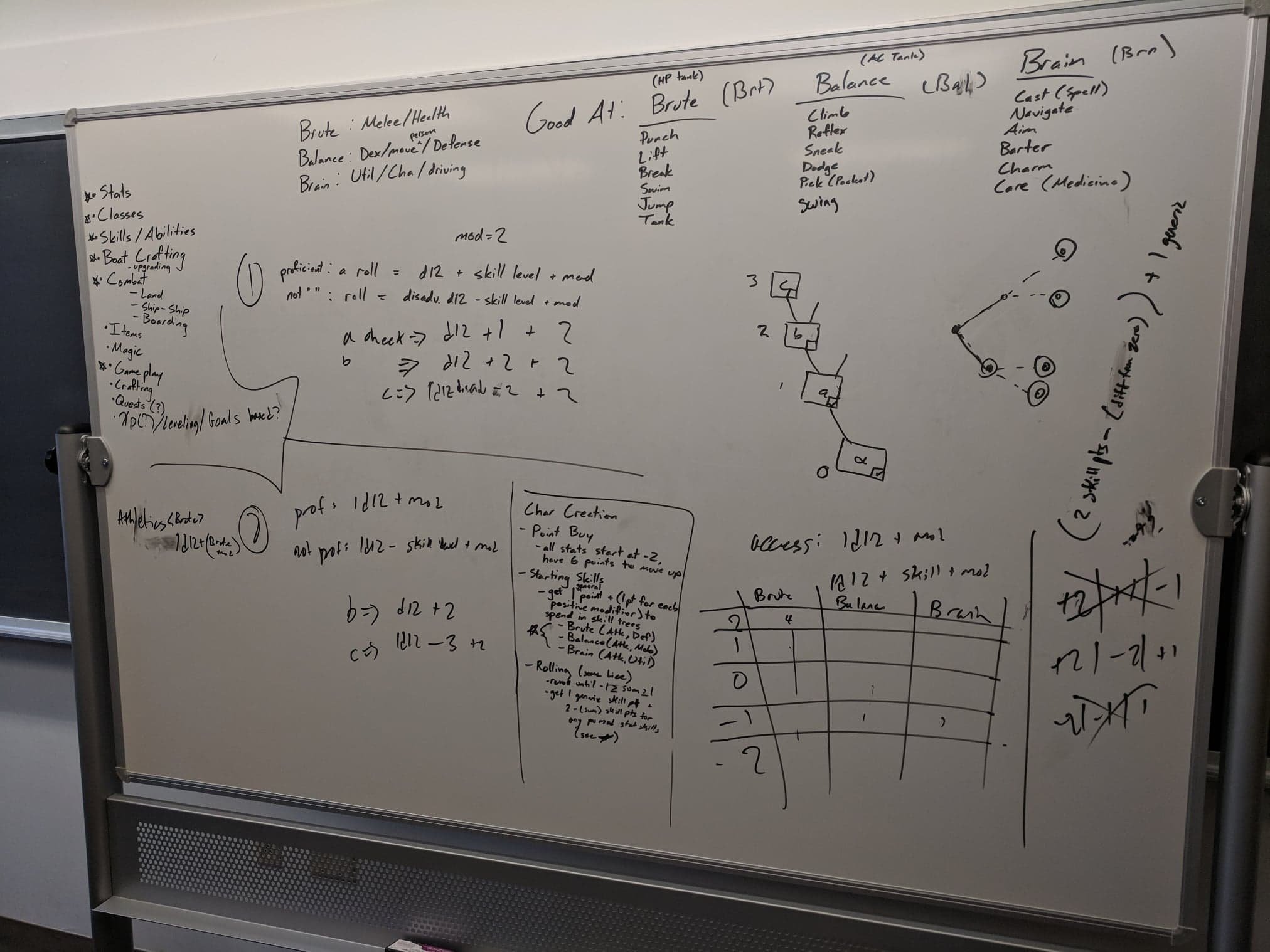Archipelago
tl;dr
I worked with a team of 2 other designers to create a TRPG based on media depicting the golden age of piracy. Our design goals were:
A fast paced, expressive combat system that transfered seamlessly between ship-vs-ship and person-vs-person scales and encourages a degree of tactical thought.
Many meaninful avenues for character customization.
An emphasis on translating the panache and excitement of works like The Secret of Monkey Island and The Pirates of Penzance into a storytelling ruleset.
The crew of the Scuttlebud looks off into the foggy recesses of the uncharted island, searching for any trace of the treasure that they were promised. Stewart, a professor-turned-seafarer, holds up the tattered map that they got off of an old drunk at the last port, comparing land marks to the scene in front of them. A sudden noise catches their attention, and the crew has but a moment to react as a skeleton leaps aboard their ship.
For just over a year, I and two friends worked on a pirate-themed TRPG that we gave the working title of Archipelago. While we stopped working on the project before we brought it to a fully polished, release-worthy state, the game is playable and has a rules PDF that can be viewed here.
The goal for Archipelago was to create a fun, fast-paced game that allowed for interesting, tactical combat without getting too bogged down in the rules. We also wanted to focus on character customization and non-combat utility. The system would be used primarily for longer running games, in a similar way that Dungeons & Dragons and Pathfinder have robust character advancement systems that let characters grow over the course of their adventures.
While we were making a TRPG, some of our biggest inspirations were actually video games. Path of Exile, Darkest Dungeon, Divinity: Original Sin 2, and The Curse of Monkey Island were names that were thrown around nearly every time we met up to work on the game. We also drew inspiration from movies such as The Pirates of Penzance and Pirates of the Caribbean, as well as referencing a few TRPGs such as Seventh Sea, FATE, and Stars without Number.
The core of the character advancement system was based on branching skill trees. Each character had access to the Attack, Defense, Mobility, and Utility trees alongside a special tree for their character class. The base classes of the game were the Academic, Juggernaut, Occultist, Swashbuckler, Menagerist, Flintlock, and Jester. Each of these was designed to pull at a specific aspect of fantastical piracy that we found interesting, such as partnering with a monkey or parrot (Menagerist), tinkering with rudimentary guns (Flintlock), mounting a ship’s cannon on your back (Juggernaut), or communing with the spirits that haunt buried treasure (Occultist). For our first playtest, we created the start of the class trees for the Academic, Juggernaut, Occultist, and Swashbuckler.
Something that we knew would be incredibly important for a game that hoped to ape the golden age of piracy was ship mechanics. We needed something streamlined and satisfying for both travel and combat, and while what we came up with did need some fine tuning, it was actually the most successful part of the design!
Each ship had a number of hexes that it could move and a number of increments that it could turn in a single round. While on paper the notation looked complex, it turned out to be incredibly fluid and fun to use.
What held all of our systems together was an AP system similar to that employed in D:OS 2 and, for combat, the zone system.
Every action that players took on their turn would use a certain amount of AP. This gave players a lot of freedom to build their turns how they wanted. They could spend all of their AP on a single, huge attack (a hallmark of the Juggernaut), or perform a series of small maneuvers that could build towards a big finish (as would have been the M.O. of the Jester).
This worked hand in hand with the zone combat system, which broke a battlefield up not into squares a la Dungeons & Dragons, but instead zones that shared similar attributes. A market with a fountain in the center, for example, might be broken up into five zones: one for the fountain and one each for four banks of stalls. Each zone would then have a series of tags, such as “wet” or “haunted,” which players (especially Occultists) take advantage of to pull of flashy feats that would wow even Captain Jack Sparrow.
Ultimately, Archipelago’s first iteration suffered from conflicting identities. Because of the heavy video game influences, there were some elements that felt very specifically and tightly designed. However, there were also elements (especially those meant to be used outside of combat) that felt more like FATE aspects and undermined the more specifically worded mechanics.




